roof NISSAN PATHFINDER 2023 Owners Manual
[x] Cancel search | Manufacturer: NISSAN, Model Year: 2023, Model line: PATHFINDER, Model: NISSAN PATHFINDER 2023Pages: 665, PDF Size: 4.64 MB
Page 4 of 665
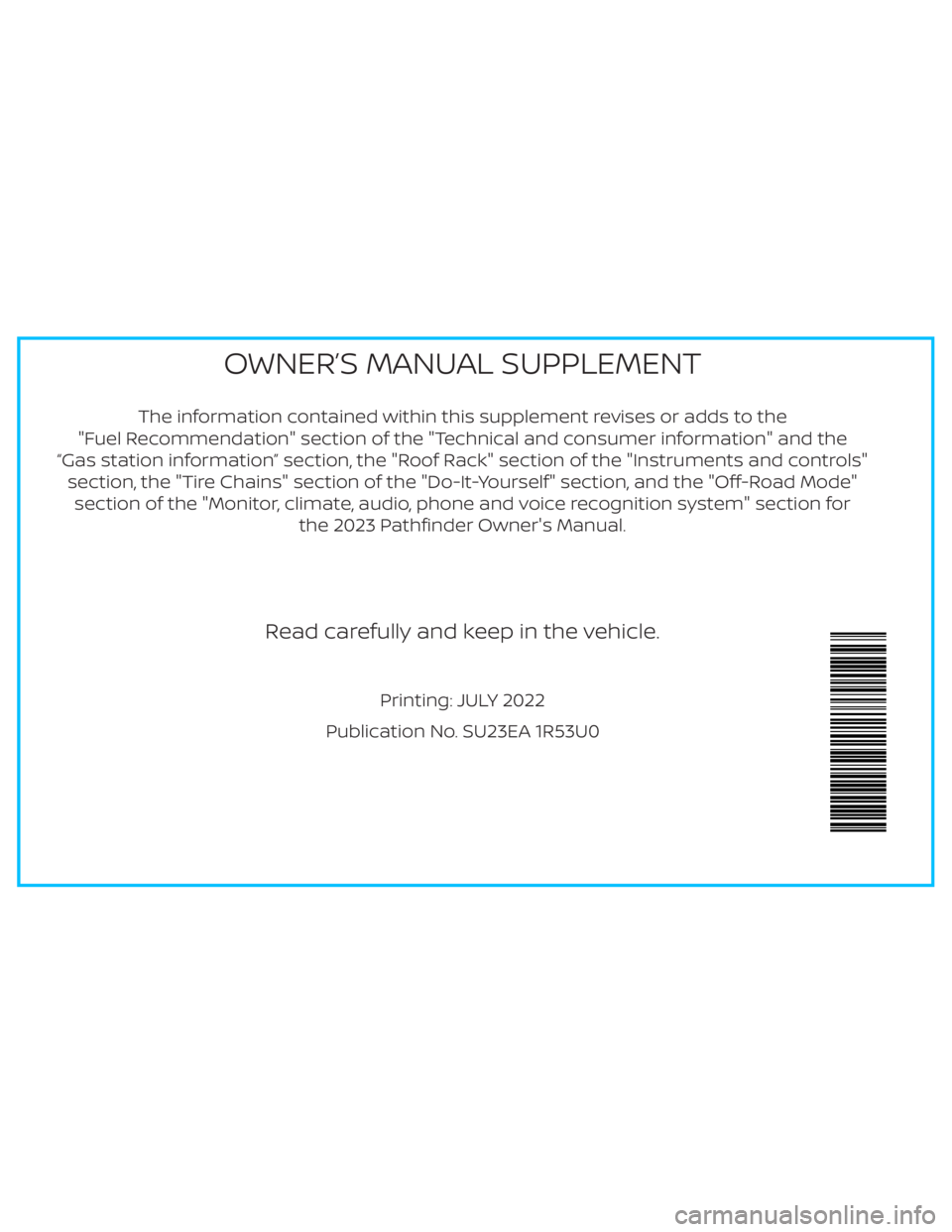
The information contained within this supplement revises or adds to the
"Fuel Recommendation" section of the "Technical and consumer information" and the
“Gas station information” section, the "Roof Rack" section of the "Instruments and controls"
section, the "Tire Chains" section of the "Do-It-Yourself" section, and the "Off-Road Mode"
section of the "Monitor, climate, audio, phone and voice recognition system" section for
the 2023 Pathfinder Owner's Manual.
Read carefully and keep in the vehicle.
Printing: JULY 2022
Publication No. SU23EA 1R53U0
OWNER’S MANUAL SUPPLEMENT
Page 5 of 665

FUEL RECOMMENDATION
(Rock Creek)
NISSAN recommends the use of unleaded
premium gasoline with an octane rating of
at least 91 AKI (Anti-Knock Index) number
(Research octane number 96). If unleaded
premium gasoline is not available, you
may use unleaded regular gasoline with an
octane rating of at least 87 AKI number
(Research octane number 91), but you may
notice a decrease in performance.
ROOF RACK (if so equipped)
WARNING
•Always install the crossbars onto the
roof side rails before loading cargo of
any kind. Loading cargo directly onto
the roof rack or the vehicle’s roof may
cause vehicle damage.
•Do not put load directly on the roof
rack. To avoid damage to paint, the
rubber seal and plastic supports,
use sof t padding or sof t cloth on the
crossbar before putting rough sur-
face load like plywood, lumber, etc.•Do not remove load label on both
sides of the front stanchions.
•Do not exceed maximum roof rack
load capacity and always distribute
the load uniformly. Heavy loading
of the roof rack has the potential
to affect the vehicle stability and
handling during sudden or unusual
handling maneuvers.
•
Properly secure all cargo with ropes or
straps to help prevent it from sliding or
shif ting. In a sudden stop or collision,
unsecured cargo could cause personal
injury.
•Drive extra carefully when the vehicle
is loaded at or near the cargo carry-
ing capacity, especially if the signifi-
cant portion of that load is carried on
the roof rack.
CAUTION
•Use care when placing or removing
items from the roof rack. If you can-
not comfortably lif t the items onto
the roof rack from the ground, use a
ladder or a stool.
LIC5334
Roof rack (for Rock Creek)
Page 6 of 665
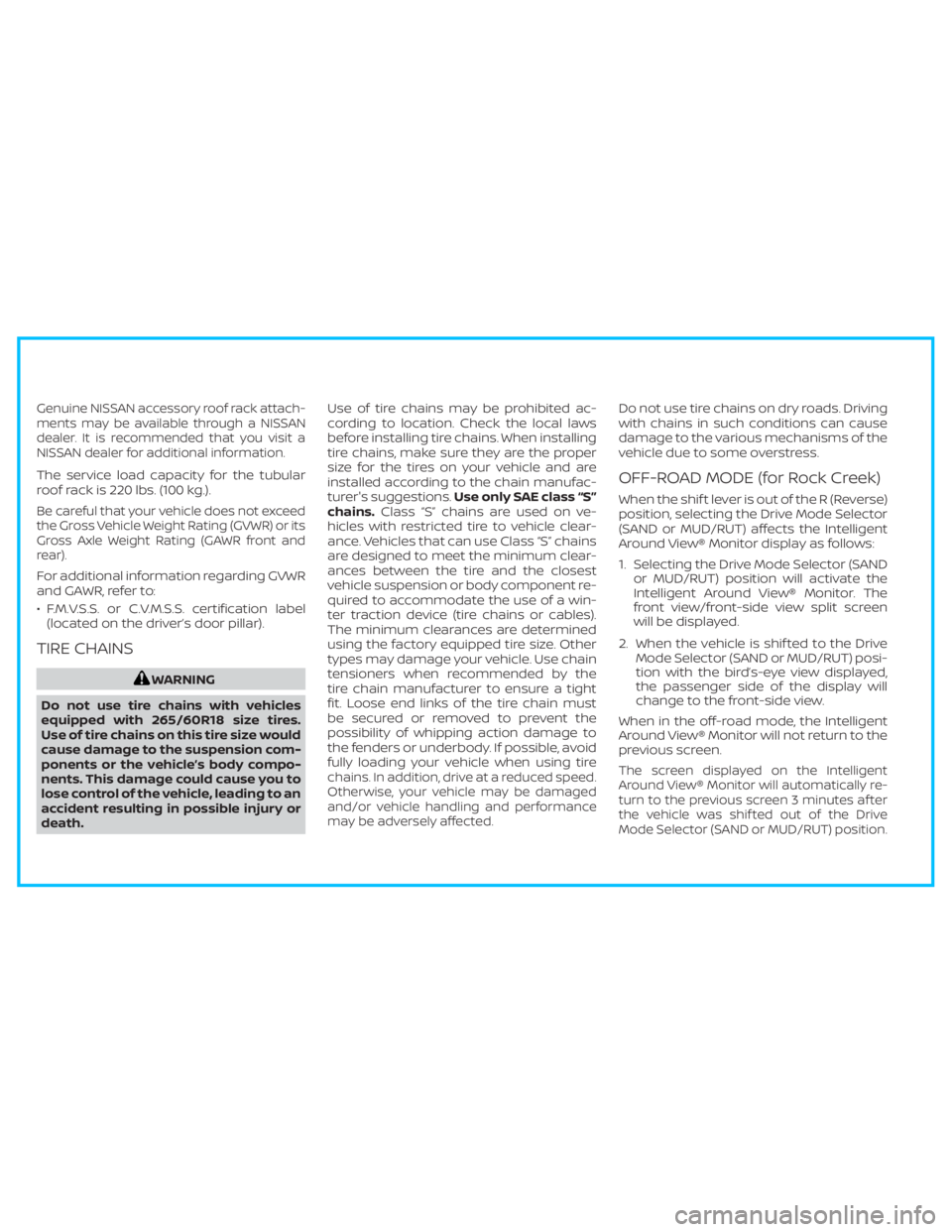
Genuine NISSAN accessory roof rack attach-
ments may be available through a NISSAN
dealer. It is recommended that you visit a
NISSAN dealer for additional information.
The service load capacity for the tubular
roof rack is 220 lbs. (100 kg.).
Be careful that your vehicle does not exceed
the Gross Vehicle Weight Rating (GVWR) or its
Gross Axle Weight Rating (GAWR front and
rear).
For additional information regarding GVWR
and GAWR, refer to:
• F.M.V.S.S. or C.V.M.S.S. certification label
(located on the driver’s door pillar).
TIRE CHAINS
WARNING
Do not use tire chains with vehicles
equipped with 265/60R18 size tires.
Use of tire chains on this tire size would
cause damage to the suspension com-
ponents or the vehicle’s body compo-
nents. This damage could cause you to
lose control of the vehicle, leading to an
accident resulting in possible injury or
death.Use of tire chains may be prohibited ac-
cording to location. Check the local laws
before installing tire chains. When installing
tire chains, make sure they are the proper
size for the tires on your vehicle and are
installed according to the chain manufac-
turer's suggestions.Use only SAE class “S”
chains.Class “S” chains are used on ve-
hicles with restricted tire to vehicle clear-
ance. Vehicles that can use Class “S” chains
are designed to meet the minimum clear-
ances between the tire and the closest
vehicle suspension or body component re-
quired to accommodate the use of a win-
ter traction device (tire chains or cables).
The minimum clearances are determined
using the factory equipped tire size. Other
types may damage your vehicle. Use chain
tensioners when recommended by the
tire chain manufacturer to ensure a tight
fit. Loose end links of the tire chain must
be secured or removed to prevent the
possibility of whipping action damage to
the fenders or underbody. If possible, avoid
fully loading your vehicle when using tire
chains. In addition, drive at a reduced speed.
Otherwise, your vehicle may be damaged
and/or vehicle handling and performance
may be adversely affected.
Do not use tire chains on dry roads. Driving
with chains in such conditions can cause
damage to the various mechanisms of the
vehicle due to some overstress.
OFF-ROAD MODE (for Rock Creek)
When the shif t lever is out of the R (Reverse)
position, selecting the Drive Mode Selector
(SAND or MUD/RUT) affects the Intelligent
Around View® Monitor display as follows:
1. Selecting the Drive Mode Selector (SAND
or MUD/RUT) position will activate the
Intelligent Around View® Monitor. The
front view/front-side view split screen
will be displayed.
2. When the vehicle is shif ted to the Drive
Mode Selector (SAND or MUD/RUT) posi-
tion with the bird’s-eye view displayed,
the passenger side of the display will
change to the front-side view.
When in the off-road mode, the Intelligent
Around View® Monitor will not return to the
previous screen.
The screen displayed on the Intelligent
Around View® Monitor will automatically re-
turn to the previous screen 3 minutes af ter
the vehicle was shif ted out of the Drive
Mode Selector (SAND or MUD/RUT) position.
Page 15 of 665
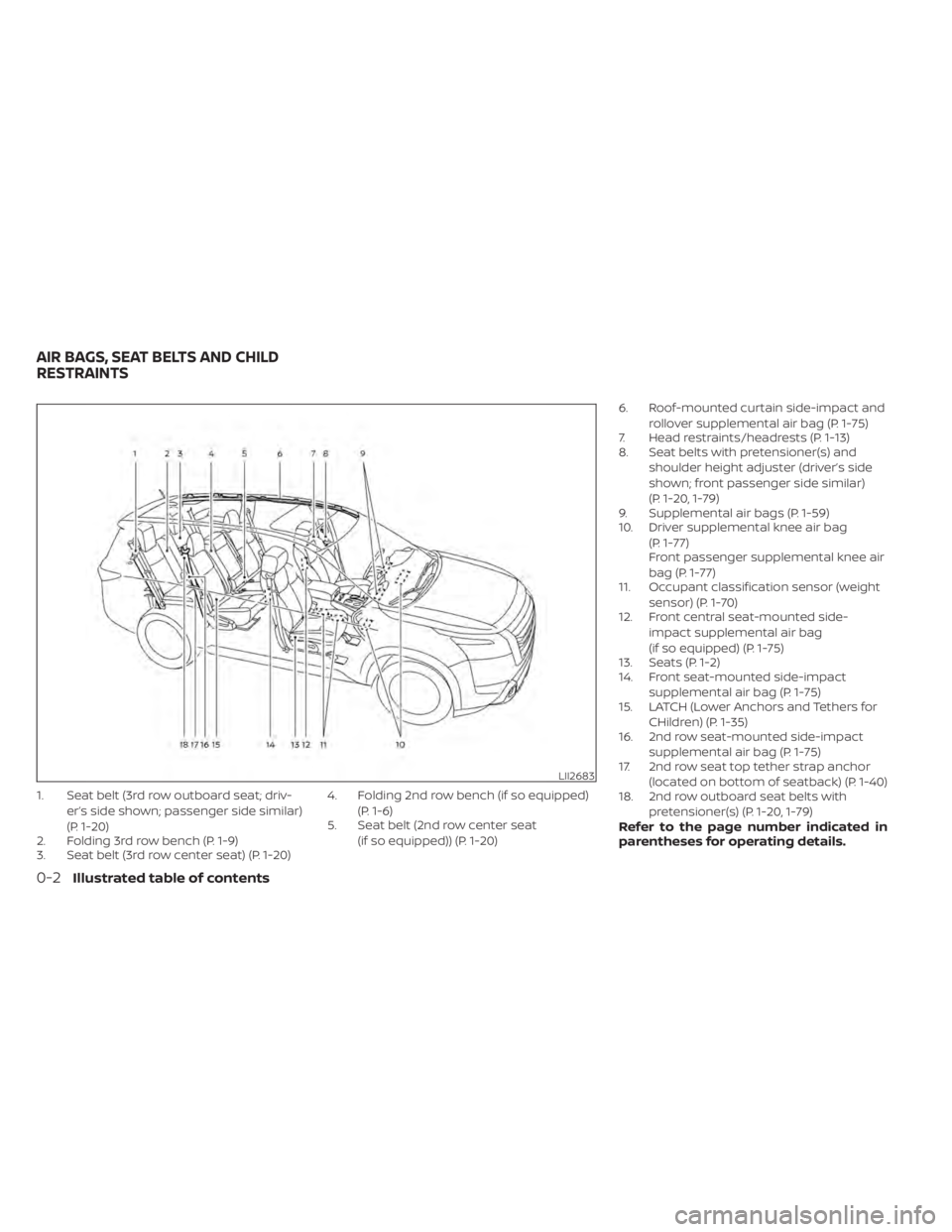
1. Seat belt (3rd row outboard seat; driv-er’s side shown; passenger side similar)
(P. 1-20)
2. Folding 3rd row bench (P. 1-9)
3. Seat belt (3rd row center seat) (P. 1-20) 4. Folding 2nd row bench (if so equipped)
(P. 1-6)
5. Seat belt (2nd row center seat
(if so equipped)) (P. 1-20) 6. Roof-mounted curtain side-impact and
rollover supplemental air bag (P. 1-75)
7. Head restraints/headrests (P. 1-13)
8. Seat belts with pretensioner(s) and
shoulder height adjuster (driver’s side
shown; front passenger side similar)
(P. 1-20, 1-79)
9. Supplemental air bags (P. 1-59)
10. Driver supplemental knee air bag
(P. 1-77)
Front passenger supplemental knee air
bag (P. 1-77)
11. Occupant classification sensor (weight
sensor) (P. 1-70)
12. Front central seat-mounted side-
impact supplemental air bag
(if so equipped) (P. 1-75)
13. Seats (P. 1-2)
14. Front seat-mounted side-impact
supplemental air bag (P. 1-75)
15. LATCH (Lower Anchors and Tethers for
CHildren) (P. 1-35)
16. 2nd row seat-mounted side-impact
supplemental air bag (P. 1-75)
17. 2nd row seat top tether strap anchor
(located on bottom of seatback) (P. 1-40)
18. 2nd row outboard seat belts with
pretensioner(s) (P. 1-20, 1-79)
Refer to the page number indicated in
parentheses for operating details.
LII2683
AIR BAGS, SEAT BELTS AND CHILD
RESTRAINTS
0-2Illustrated table of contents
Page 18 of 665
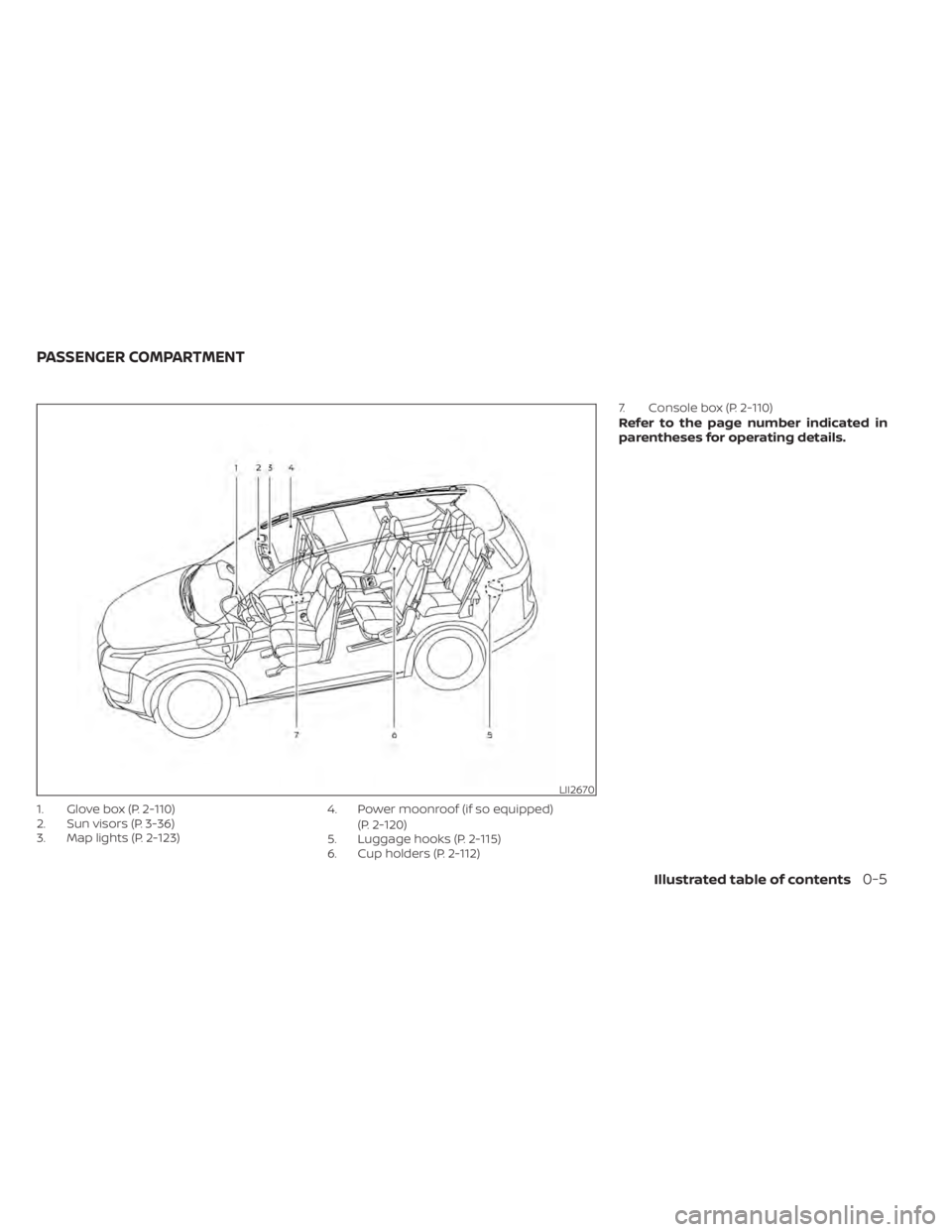
1. Glove box (P. 2-110)
2. Sun visors (P. 3-36)
3. Map lights (P. 2-123)4. Power moonroof (if so equipped)
(P. 2-120)
5. Luggage hooks (P. 2-115)
6. Cup holders (P. 2-112) 7. Console box (P. 2-110)
Refer to the page number indicated in
parentheses for operating details.
LII2670
PASSENGER COMPARTMENT
Illustrated table of contents0-5
Page 25 of 665
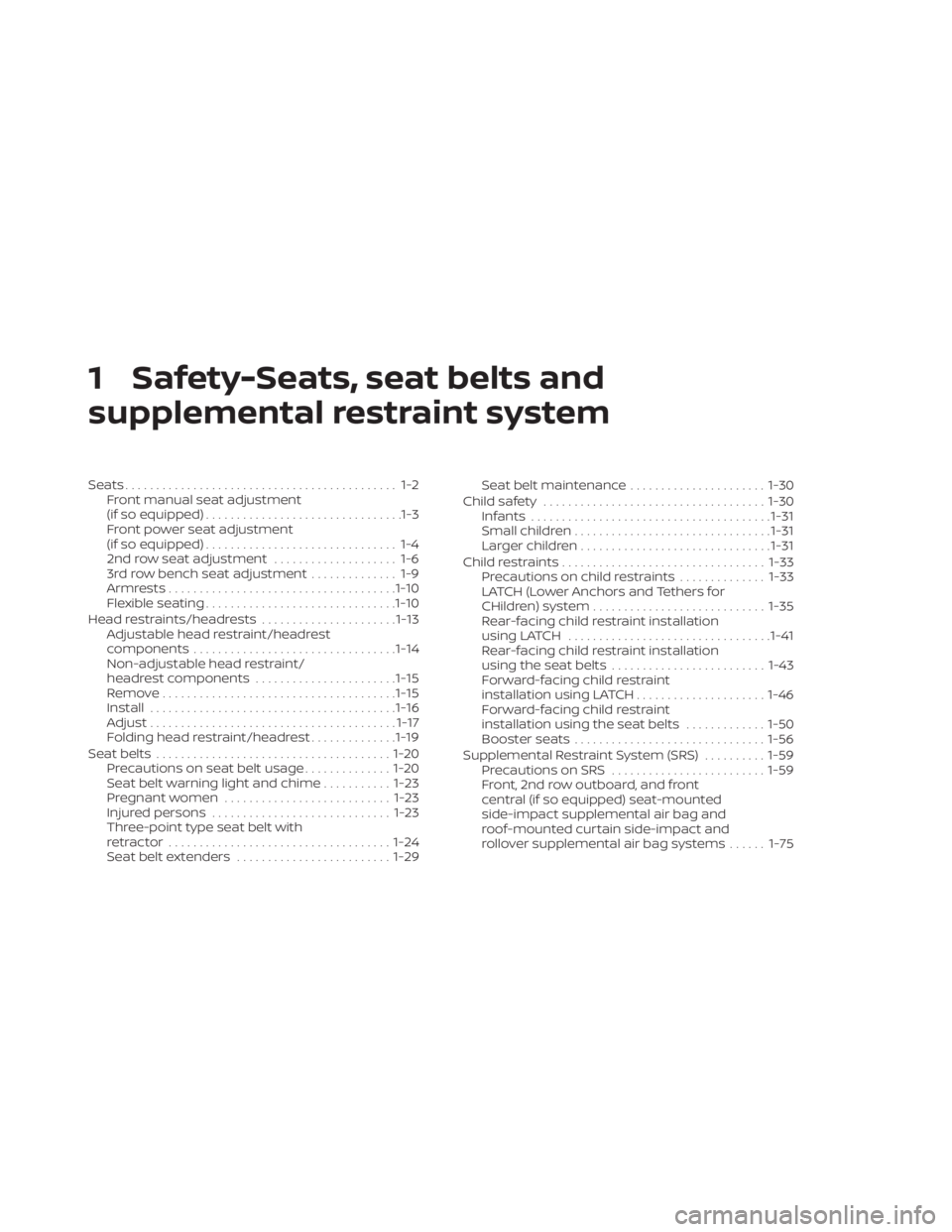
1 Safety-Seats, seat belts and
supplemental restraint system
Seats............................................ 1-2Front manual seat adjustment
(if so equipped) ................................1-3
Front power seat adjustment
(if so equipped) ............................... 1-4
2nd row seat adjustment .................... 1-6
3rd row bench seat adjustment .............. 1-9
Armrests ..................................... 1-10
Flexible seating ............................... 1-10
Head restraints/headrests ......................1-13
Adjustable head restraint/headrest
components ................................. 1-14
Non-adjustable head restraint/
headrest components .......................1-15
Remove...................................... 1-15
Install ........................................ 1-16
Adjust ........................................ 1-17
Folding head restraint/headrest ..............1-19
Seatbelts ...................................... 1-20
Precautions on seat belt usage ..............1-20
Seat belt warning light and chime ...........1-23
Pregnant women ........................... 1-23
Injured persons ............................. 1-23
Three-point type seat belt with
retractor .................................... 1-24
Seat belt extenders ......................... 1-29Seat belt maintenance
......................1-30
Child safety .................................... 1-30
Infants ....................................... 1-31
Small children ................................ 1-31
Larger children ............................... 1-31
Child restraints ................................. 1-33
Precautions on child restraints ..............1-33
LATCH (Lower Anchors and Tethers for
CHildren) system ............................ 1-35
Rear-facing child restraint installation
using LATCH ................................. 1-41
Rear-facing child restraint installation
using the seat belts ......................... 1-43
Forward-facing child restraint
installation using LATCH .....................1-46
Forward-facing child restraint
installation using the seat belts .............1-50
Booster seats ............................... 1-56
Supplemental Restraint System (SRS) ..........1-59
Precautions on SRS ......................... 1-59
Front, 2nd row outboard, and front
central (if so equipped) seat-mounted
side-impact supplemental air bag and
roof-mounted curtain side-impact and
rollover supplemental air bag systems ......
1-75
Page 84 of 665
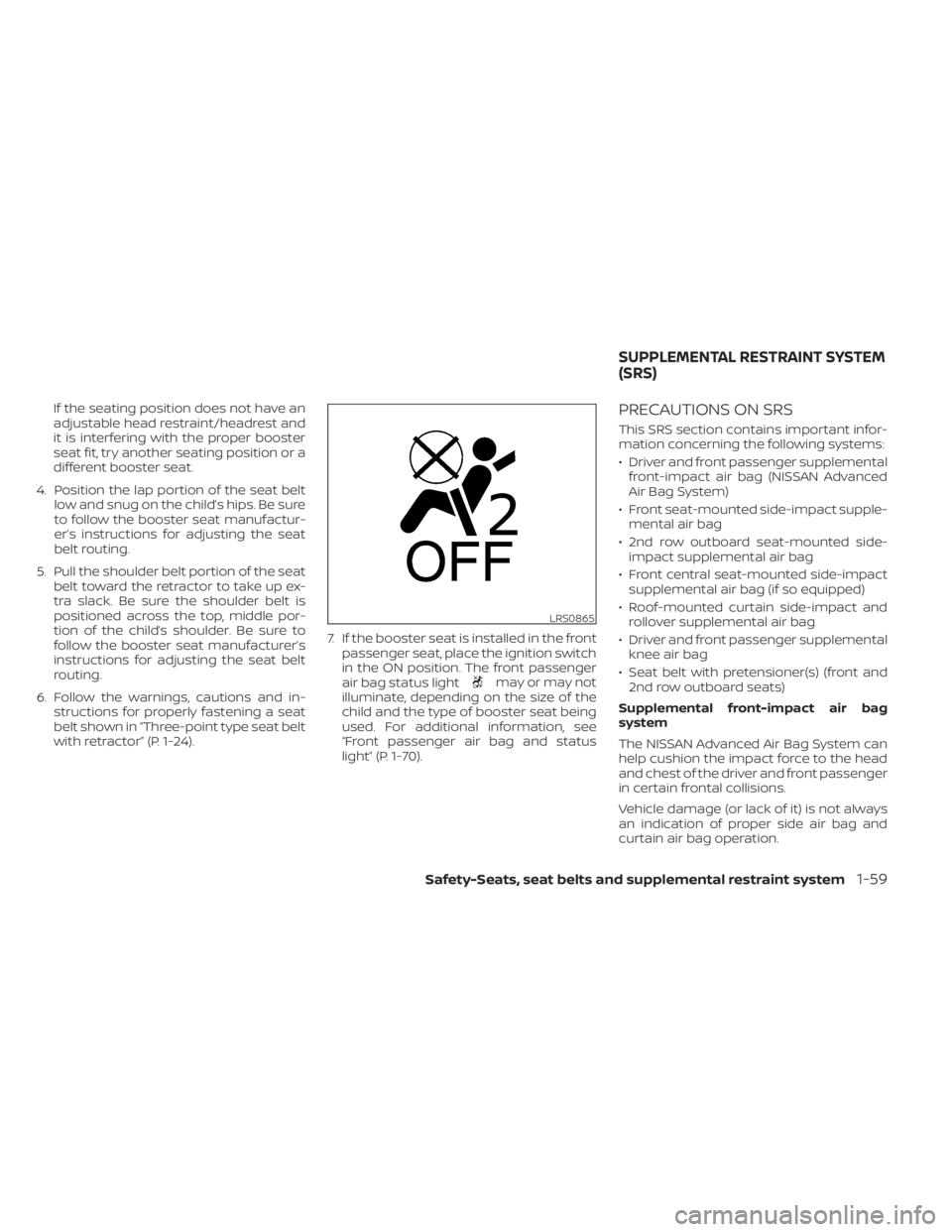
If the seating position does not have an
adjustable head restraint/headrest and
it is interfering with the proper booster
seat fit, try another seating position or a
different booster seat.
4. Position the lap portion of the seat belt low and snug on the child’s hips. Be sure
to follow the booster seat manufactur-
er’s instructions for adjusting the seat
belt routing.
5. Pull the shoulder belt portion of the seat belt toward the retractor to take up ex-
tra slack. Be sure the shoulder belt is
positioned across the top, middle por-
tion of the child’s shoulder. Be sure to
follow the booster seat manufacturer’s
instructions for adjusting the seat belt
routing.
6. Follow the warnings, cautions and in- structions for properly fastening a seat
belt shown in “Three-point type seat belt
with retractor” (P. 1-24). 7. If the booster seat is installed in the front
passenger seat, place the ignition switch
in the ON position. The front passenger
air bag status light
may or may not
illuminate, depending on the size of the
child and the type of booster seat being
used. For additional information, see
“Front passenger air bag and status
light” (P. 1-70).
PRECAUTIONS ON SRS
This SRS section contains important infor-
mation concerning the following systems:
• Driver and front passenger supplemental front-impact air bag (NISSAN Advanced
Air Bag System)
• Front seat-mounted side-impact supple- mental air bag
• 2nd row outboard seat-mounted side- impact supplemental air bag
• Front central seat-mounted side-impact supplemental air bag (if so equipped)
• Roof-mounted curtain side-impact and rollover supplemental air bag
• Driver and front passenger supplemental knee air bag
• Seat belt with pretensioner(s) (front and 2nd row outboard seats)
Supplemental front-impact air bag
system
The NISSAN Advanced Air Bag System can
help cushion the impact force to the head
and chest of the driver and front passenger
in certain frontal collisions.
Vehicle damage (or lack of it) is not always
an indication of proper side air bag and
curtain air bag operation.
LRS0865
SUPPLEMENTAL RESTRAINT SYSTEM
(SRS)
Safety-Seats, seat belts and supplemental restraint system1-59
Page 85 of 665
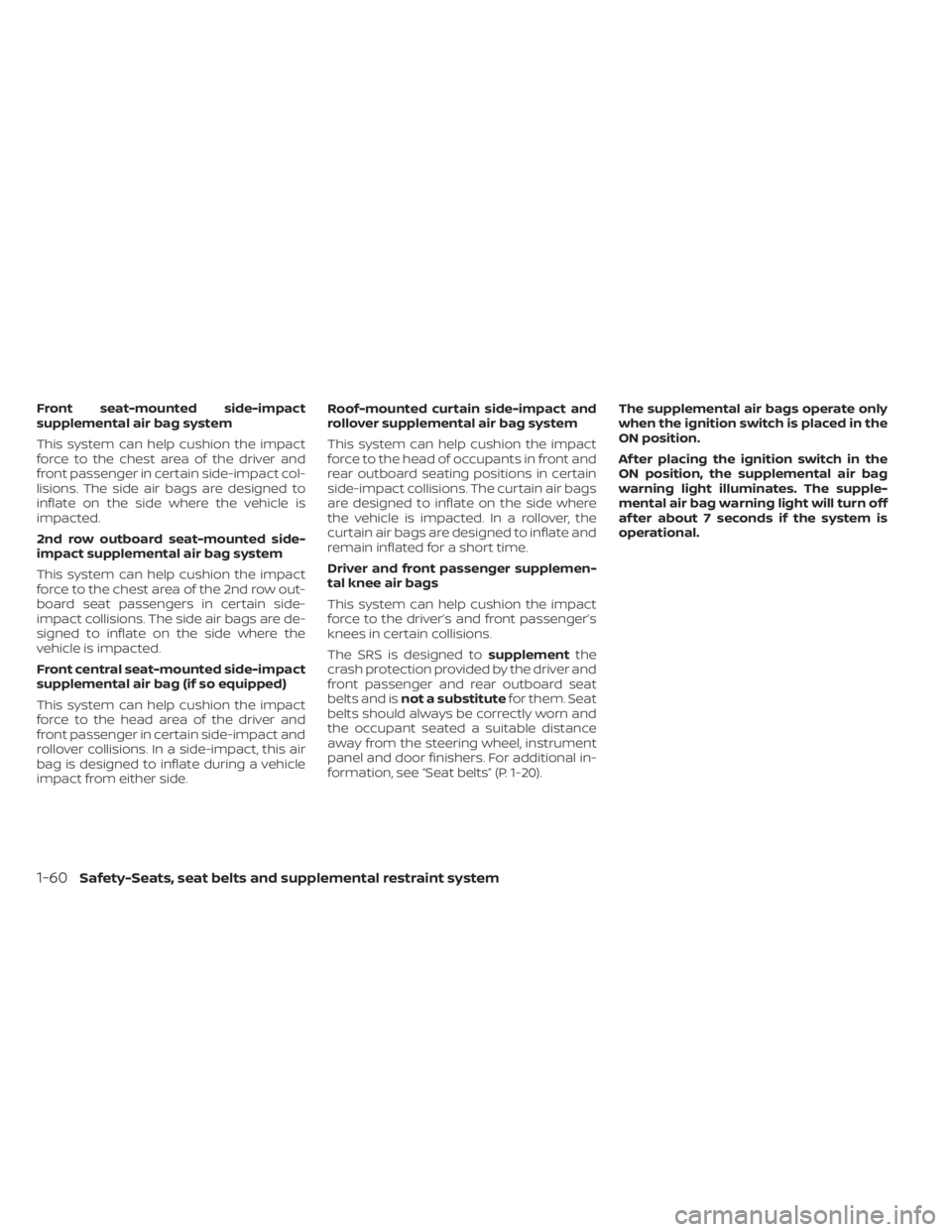
Front seat-mounted side-impact
supplemental air bag system
This system can help cushion the impact
force to the chest area of the driver and
front passenger in certain side-impact col-
lisions. The side air bags are designed to
inflate on the side where the vehicle is
impacted.
2nd row outboard seat-mounted side-
impact supplemental air bag system
This system can help cushion the impact
force to the chest area of the 2nd row out-
board seat passengers in certain side-
impact collisions. The side air bags are de-
signed to inflate on the side where the
vehicle is impacted.
Front central seat-mounted side-impact
supplemental air bag (if so equipped)
This system can help cushion the impact
force to the head area of the driver and
front passenger in certain side-impact and
rollover collisions. In a side-impact, this air
bag is designed to inflate during a vehicle
impact from either side.Roof-mounted curtain side-impact and
rollover supplemental air bag system
This system can help cushion the impact
force to the head of occupants in front and
rear outboard seating positions in certain
side-impact collisions. The curtain air bags
are designed to inflate on the side where
the vehicle is impacted. In a rollover, the
curtain air bags are designed to inflate and
remain inflated for a short time.
Driver and front passenger supplemen-
tal knee air bags
This system can help cushion the impact
force to the driver’s and front passenger’s
knees in certain collisions.
The SRS is designed to
supplementthe
crash protection provided by the driver and
front passenger and rear outboard seat
belts and is not a substitute for them. Seat
belts should always be correctly worn and
the occupant seated a suitable distance
away from the steering wheel, instrument
panel and door finishers. For additional in-
formation, see “Seat belts” (P. 1-20). The supplemental air bags operate only
when the ignition switch is placed in the
ON position.
Af ter placing the ignition switch in the
ON position, the supplemental air bag
warning light illuminates. The supple-
mental air bag warning light will turn off
af ter about 7 seconds if the system is
operational.
1-60Safety-Seats, seat belts and supplemental restraint system
Page 90 of 665
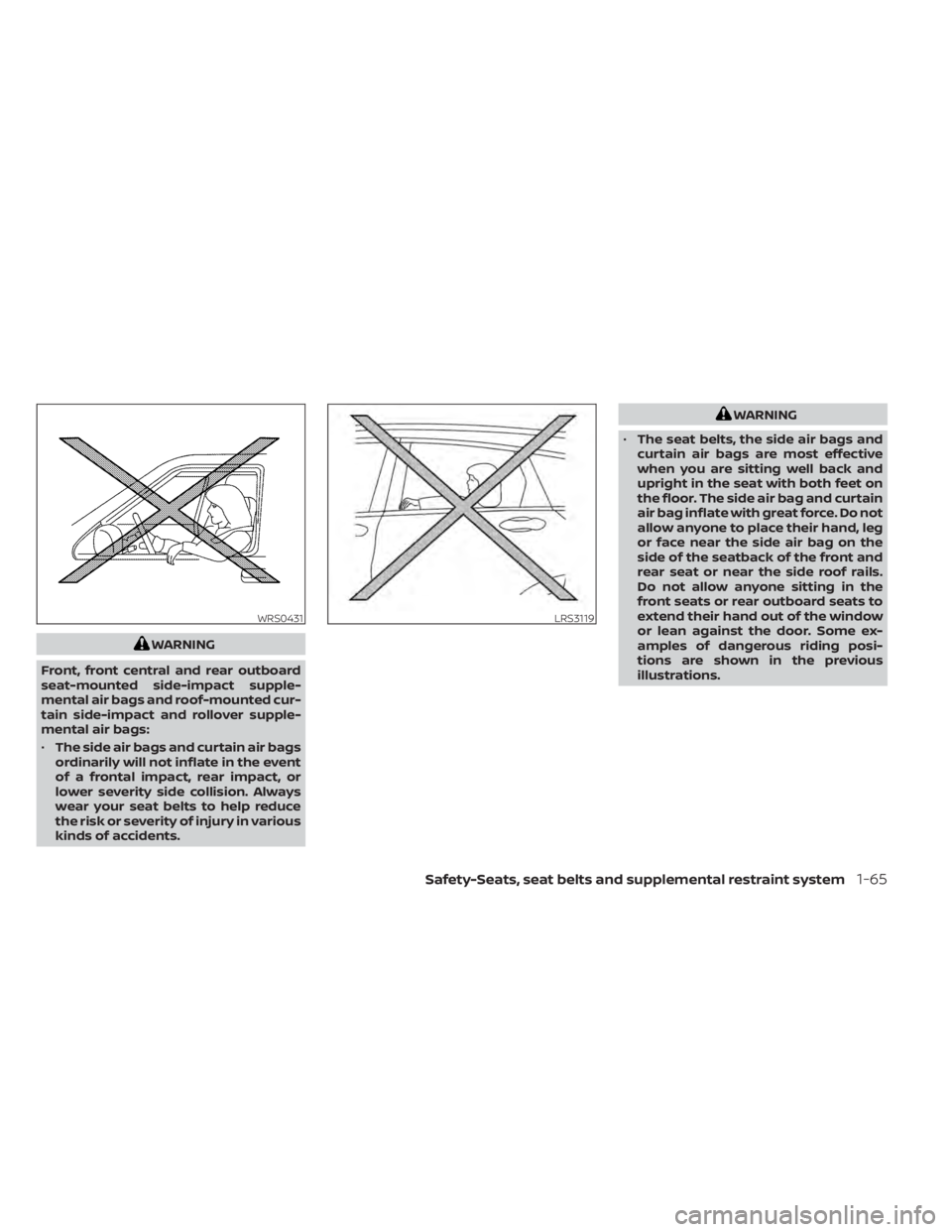
WARNING
Front, front central and rear outboard
seat-mounted side-impact supple-
mental air bags and roof-mounted cur-
tain side-impact and rollover supple-
mental air bags:
• The side air bags and curtain air bags
ordinarily will not inflate in the event
of a frontal impact, rear impact, or
lower severity side collision. Always
wear your seat belts to help reduce
the risk or severity of injury in various
kinds of accidents.
WARNING
• The seat belts, the side air bags and
curtain air bags are most effective
when you are sitting well back and
upright in the seat with both feet on
the floor. The side air bag and curtain
air bag inflate with great force. Do not
allow anyone to place their hand, leg
or face near the side air bag on the
side of the seatback of the front and
rear seat or near the side roof rails.
Do not allow anyone sitting in the
front seats or rear outboard seats to
extend their hand out of the window
or lean against the door. Some ex-
amples of dangerous riding posi-
tions are shown in the previous
illustrations.
WRS0431LRS3119
Safety-Seats, seat belts and supplemental restraint system1-65
Page 92 of 665
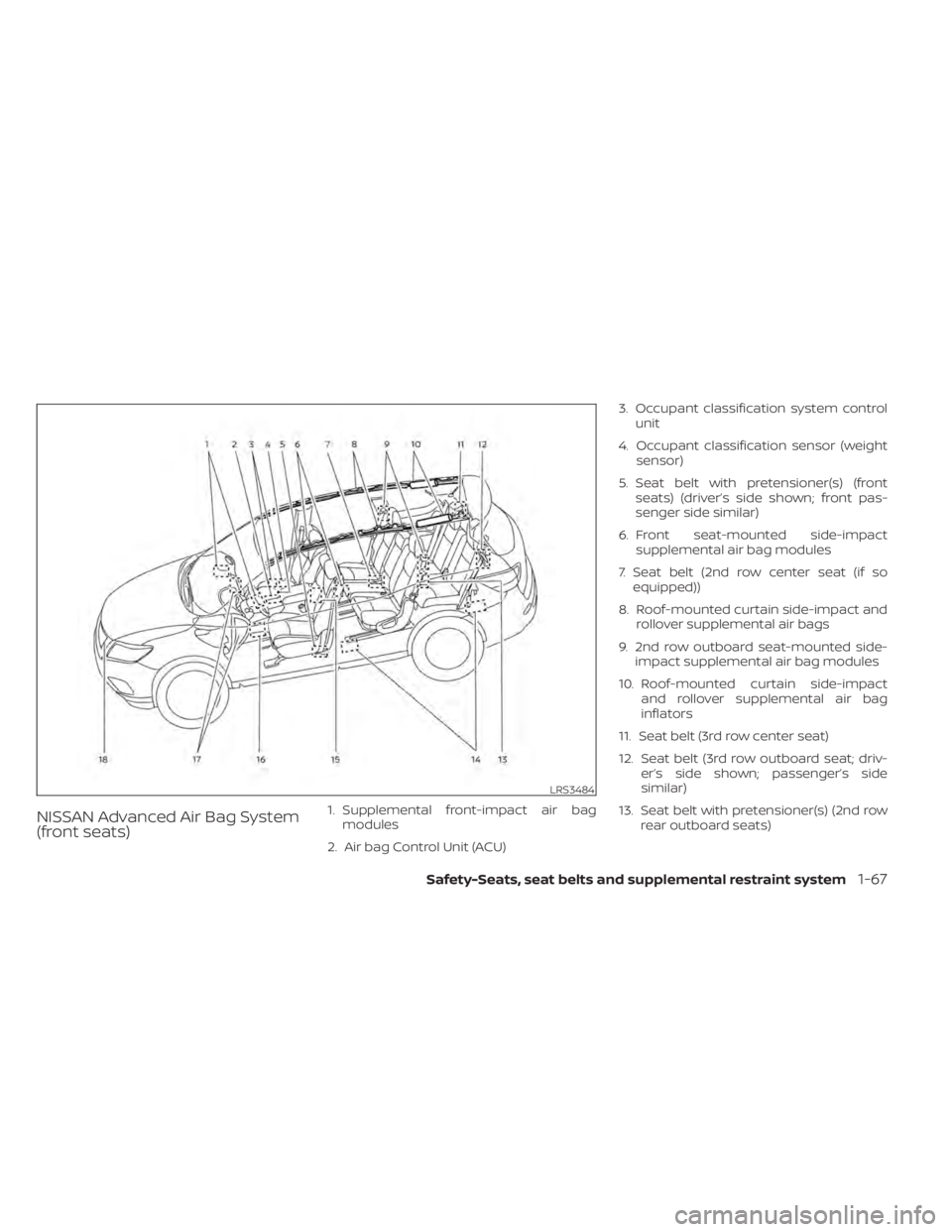
NISSAN Advanced Air Bag System
(front seats)1. Supplemental front-impact air bagmodules
2. Air bag Control Unit (ACU) 3. Occupant classification system control
unit
4. Occupant classification sensor (weight sensor)
5. Seat belt with pretensioner(s) (front seats) (driver’s side shown; front pas-
senger side similar)
6. Front seat-mounted side-impact supplemental air bag modules
7. Seat belt (2nd row center seat (if so equipped))
8. Roof-mounted curtain side-impact and rollover supplemental air bags
9. 2nd row outboard seat-mounted side- impact supplemental air bag modules
10. Roof-mounted curtain side-impact and rollover supplemental air bag
inflators
11. Seat belt (3rd row center seat)
12. Seat belt (3rd row outboard seat; driv- er’s side shown; passenger’s side
similar)
13. Seat belt with pretensioner(s) (2nd row rear outboard seats)
LRS3484
Safety-Seats, seat belts and supplemental restraint system1-67